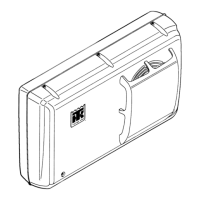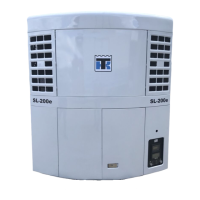Operating Instructions (Rev 1/99)
25
below 5 to 11 in. Hg of vacuum (-17 to -37 kPa), the
switch opens the circuit to the power relay, which stops
the unit.
NOTE: This operation is for units with printed circuit
board manufactured prior to 3-25-96 (see “P.C. Board
P/N 41-776 (First Version)” on page 38).
When the LPCO opens on models using printed ciru-
cit board manufactured between 3-26-96 and 5-21-96,
see “P.C. Board P/N 41-1619 (Second Version)” on
page 39 or after 5-21-96 (see “P.C. Board P/N 41-
1812 (Third Version)” on page 40) the HPCO will
cycle the compressor clutch only.
5. FUSE PLUG. The fuse plug is located on the receiver
tank. It opens to relieve the pressure in the refrigera-
tion system if the pressure becomes excessive. If the
fuse plug has opened, it must be replaced. It cannot be
reused.
6. OVERLOAD RELAY (Model 20). This auto reset
relay protects the electric motor that drives the electric
standby compressor. The overload relay opens the cir-
cuit to the cab control box, which de-energizes the
motor contactor and the electric motor if the motor
overloads for any reason (e.g., low line voltage or
improper power supply) during electric standby opera-
tion. When the overload relay opens, it illuminates the
AC overload indicator.
7. TRANSFORMER FUSE (Model 20). This fuse is
located in the high voltage box. The 115 volt, single
phase, 60 Hz unit has a 10 amp fuse. All other units use
a 4 amp fuse.
UNIT OPERATION
Bi-monthly Pre-Trip Checks
The following bi-monthly pre-trip inspection should be
completed before loading the truck. While the bi-monthly
inspection is not a substitute for regularly scheduled mainte-
nance inspections, it is an important part of the preventive
maintenance program designed to head off operating prob-
lems before they happen.
1. LEAKS. Inspect for refrigerant leaks and worn refrig-
erant lines.
2. BELTS. Inspect for cracks, wear and proper tensions.
3. ELECTRICAL INSPECTION. The electrical connec-
tions should be securely fastened. Wires and terminals
should be free of corrosion, cracks or moisture.
4. DEFROST DRAINS. Check the defrost drain hoses
and fittings to make sure that they are open so conden-
sate can run out during defrost. Check the bottom end
of each drain hose to make sure that it is not plugged or
crushed.
5. STRUCTURAL INSPECTION. Visually check for
physical damage.
6. REFRIGERANT CHARGE. Check the receiver tank
sight glass for the proper charge level.
Starting the Unit
Model 10 Units
1. Start the truck engine.
2. Press the On-Off key in the cab control box to turn the
unit ON.
3. Adjust the thermostat to the proper setting.
Model 20 Units
Engine Operation
1. Start the truck engine.
2. Press the On-Off Key in the cab control box to turn the
unit ON.

